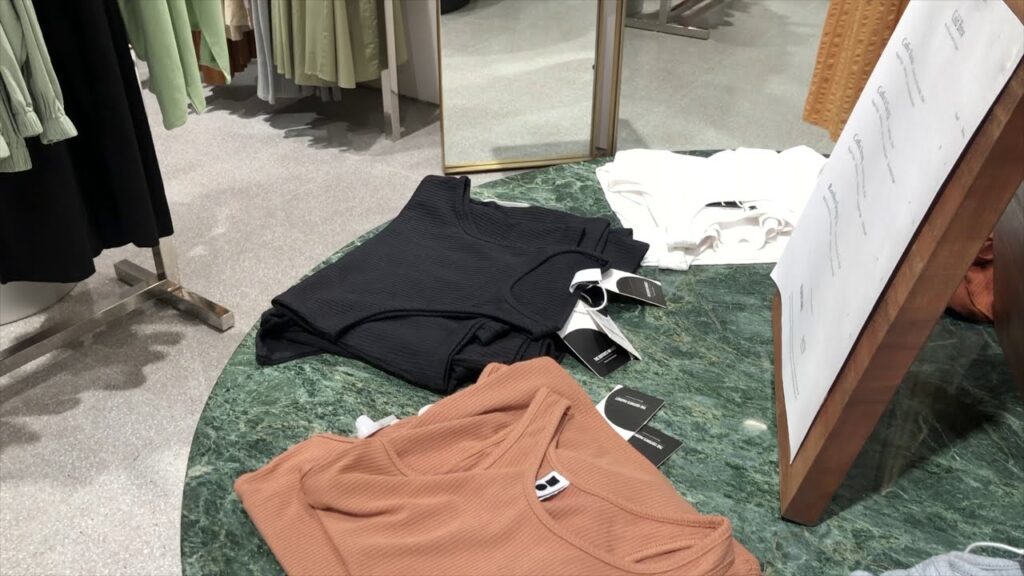Are you tired of feeling overwhelmed and lost when it comes to shopping for clothes? Do you often find yourself struggling to put together fashionable outfits or keep up with the latest trends? If so, then it’s time to learn how to shop like a fashion editor. In this article, we’ll break down the tips and tricks that fashion editors use to stay on top of their game and always look effortlessly stylish. So, grab a notebook and let’s get started!
The Importance of Shopping Like a Fashion Editor
Before we dive into the nitty-gritty details, let’s first understand why it’s essential to learn how to shop like a fashion editor. Fashion editors are known for their impeccable taste and ability to spot trends before they become mainstream. By learning their secrets, you’ll not only save time and money, but you’ll also elevate your style game and feel more confident in your clothing choices. Plus, who wouldn’t want to shop like a pro?
Now that we understand the importance, let’s explore the six key outlines of how to shop like a fashion editor.
1. Know Your Personal Style

The first step to shopping like a fashion editor is knowing your personal style. Before you hit the stores or online shops, take some time to reflect on what styles, colors, and silhouettes you’re drawn to. Are you more of a classic dresser, or do you prefer edgy and bold pieces? Knowing your personal style will help guide your shopping decisions and prevent you from making impulse purchases that don’t align with your wardrobe or personality.
How to Use: Personal Style
Once you’ve determined your personal style, use it as a guideline when shopping. Stick to pieces that fit within your chosen aesthetic and avoid buying items just because they’re trendy or on sale. This will ensure that your wardrobe stays cohesive and reflects your unique style.
Examples: Personal Style
For example, if your personal style is feminine and romantic, you may be drawn to flowy dresses in pastel colors. Stick to these types of pieces when shopping and avoid purchasing anything too structured or dark, which may not align with your personal style.
Comparisons: Personal Style
It’s essential to understand that there’s no right or wrong personal style. Just because you don’t gravitate towards current trends doesn’t mean your style is any less valid. Embrace what makes you feel confident and comfortable, and don’t compare yourself to others.
Advice: Personal Style
Take the time to experiment with different styles to discover what truly speaks to you. Don’t be afraid to step out of your comfort zone and try new things. Fashion is meant to be fun and expressive, so have fun with it and trust your instincts when it comes to your personal style.
2. Invest in Quality Basics

Fashion editors know the importance of investing in quality basics that will last for years to come. These are the building blocks of a well-rounded wardrobe that can easily be mixed and matched with trendier pieces. Think of classic white t-shirts, black jeans, a little black dress, and a well-fitted blazer. These items may seem simple, but they provide a solid foundation for creating stylish outfits.
How to Use: Quality Basics
When shopping for basics, look for high-quality materials, such as cotton, silk, or wool. Pay attention to the fit and make sure it flatters your body type. It’s worth spending a bit more on these items as they will withstand multiple wears and washes.
Examples: Quality Basics
A great example of a quality basic is a pair of black skinny jeans. They can be dressed up or down, worn year-round, and are a staple in any fashion editor’s wardrobe.
Comparisons: Quality Basics
While fast-fashion stores may offer similar styles at a lower price point, the quality will not be the same. Investing in higher quality basics may seem more expensive upfront but will save you money in the long run as they won’t need to be replaced as frequently.
Advice: Quality Basics
Don’t be afraid to splurge on quality basics that you know you’ll get a lot of use out of. These pieces will form the foundation of your wardrobe and are worth investing in for a polished and put-together look.
3. Keep an Eye on Trends
Fashion editors are always up to date on the latest trends, but that doesn’t mean they blindly follow them. Instead, they pick and choose which trends align with their personal style and incorporate them into their wardrobes in a way that feels authentic. Keeping up with trends can be overwhelming, so it’s crucial to know which ones to embrace and which ones to pass on.
How to Use: Trends
Keep an eye on fashion blogs, magazines, and social media to stay informed about current trends. When shopping, focus on trends that speak to you and fit within your personal style. Don’t feel pressured to follow every trend; instead, choose the ones that align with your aesthetic and make you excited to experiment.
Examples: Trends
For example, if animal print is trending, but it’s not your cup of tea, skip it and opt for a trend that you do love, such as statement sleeves or chunky sneakers.
Comparisons: Trends
Just because something is trendy doesn’t mean it’s right for everyone. Look for ways to incorporate trends into your wardrobe that suit your personal style and make you feel confident.
Advice: Trends
Don’t be afraid to step out of your comfort zone and try new trends, but also don’t feel obligated to follow all of them. Remember that fashion should be fun and reflective of your personal style, so choose trends that speak to you and make you feel good.
4. Mix High and Low
Fashion editors are masters at mixing high-end designer pieces with more affordable items. This creates a unique and interesting look while ensuring they don’t break the bank. Don’t shy away from shopping at both designer stores and budget-friendly retailers; instead, find a balance between the two.
How to Use: High and Low
When shopping, focus on quality pieces that will last for years to come, such as a designer handbag or statement coat. Then, look for budget-friendly items to fill in the gaps and add some fun into your wardrobe. For example, pair a designer blazer with a graphic t-shirt and jeans for a chic and effortless look.
Examples: High and Low
A great example of mixing high and low is pairing a designer dress with a pair of sneakers or a fast-fashion blouse with a designer skirt.
Comparisons: High and Low
Don’t be afraid to experiment with different price points and mix and match pieces from various brands. The key is to find a balance that works for you and your budget.
Advice: High and Low
Invest in timeless and classic pieces when it comes to high-end items, and have fun with more affordable pieces that may only be on-trend for a season or two. Remember that fashion is all about self-expression, so don’t be afraid to mix and match different price points to create a unique and personalized look.
5. Shop with Intention
Fashion editors don’t just mindlessly browse racks or scroll through online shops; they shop with intention. They have a clear idea of what they need or want and focus on finding those particular items. Shopping with intention not only saves time but also prevents impulse purchases that may sit in your closet unworn.
How to Use: Shopping with Intention
Before heading out to shop, take some time to assess your wardrobe and identify any gaps or key pieces you may need. This will help guide your shopping decisions and keep you focused on what you actually need rather than getting caught up in the excitement of a sale.
Examples: Shopping with Intention
For example, if you know you need a new pair of dress pants for work, focus on finding that particular item rather than getting sidetracked by other items on sale.
Comparisons: Shopping with Intention
Shopping with intention also means avoiding impulse purchases. As tempting as it may be to buy something because it’s on sale or looks cute, remember to ask yourself if it aligns with your personal style and if you truly need it.
Advice: Shopping with Intention
Don’t let sales or flashy displays distract you from your intended shopping goals. Stay focused and stick to your list to avoid overspending or buying items you don’t actually need.
6. Don’t Be Afraid to Tailor
One secret that fashion editors swear by is tailoring. They understand the importance of a perfect fit and aren’t afraid to have their clothes altered to ensure they look their best. Tailoring can elevate any outfit and make even inexpensive pieces look high-end.
How to Use: Tailoring
When shopping, pay attention to the fit of each garment. Remember that most clothes are made to fit a general body type, so don’t be discouraged if something doesn’t fit you perfectly off the rack. Instead, invest in a good tailor who can alter clothes to fit your body like a glove.
Examples: Tailoring
A great example of tailoring is having a dress hemmed to the perfect length or taking in a blazer to fit your waist better.
Comparisons: Tailoring
Tailoring can be seen as an added expense, but it’s worth it for creating a polished and put-together look. Plus, it’s often more cost-effective to tailor a piece you already own rather than constantly buying new clothes in search of the perfect fit.
Advice: Tailoring
Don’t be afraid to have your clothes tailored, even if it’s just for a small adjustment. The right fit can make all the difference in how an outfit looks and feels.
FAQs
1. Is it necessary to follow trends to shop like a fashion editor?
No, it’s not necessary to follow every trend to shop like a fashion editor. Focus on trends that align with your personal style and make you feel confident.
2. How can I develop my personal style?
Take the time to experiment with different styles and find what speaks to you. Don’t be afraid to step out of your comfort zone and trust your instincts when it comes to your personal style.
3. Can I mix high-end designer pieces with more affordable items?
Absolutely! Mixing high and low is a great way to create a unique and personalized look while staying within your budget.
4. Is it worth investing in quality basics?
Yes, investing in quality basics will save you money in the long run as they won’t need to be replaced as frequently. Plus, they provide a solid foundation for creating stylish outfits.
5. Why is tailoring important?
Tailoring ensures that your clothes fit your body perfectly, creating a polished and put-together look. It can also elevate inexpensive pieces and make them look high-end.
Conclusion
Shopping like a fashion editor may seem intimidating at first, but by following these six key outlines, you’ll be well on your way to becoming a pro. Remember to focus on your personal style, invest in quality basics, keep up with trends, mix high and low, shop with intention, and don’t be afraid to tailor your clothes. With these tips and tricks, you’ll have a wardrobe that reflects your unique style and always looks effortlessly chic. Happy shopping!

